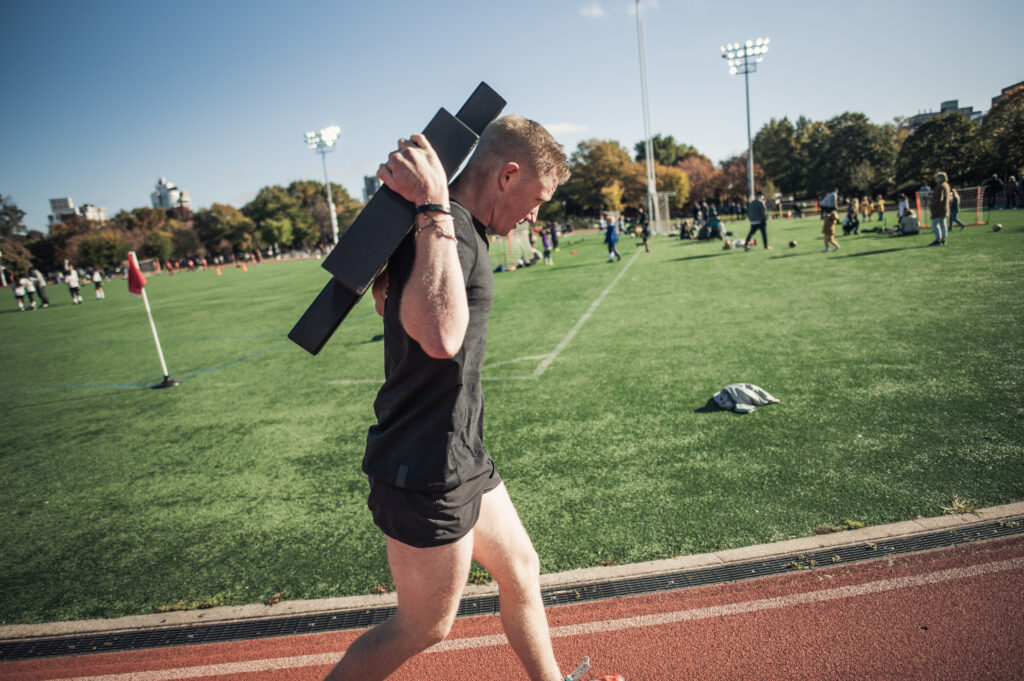Becoming a hybrid athlete is a pursuit of high performance across multiple fitness disciplines. Hybrid athlete training mostly blends strength training and endurance training (also with skill and agility) into a cohesive hybrid training program. But, it challenges the traditional boundaries of fitness. The hybrid athlete’s challenge is finding that delicate balance to avoid the pitfalls of overtraining and burnout. Something that’s very hard to do.
Related: 4 workout plans to train like a hybrid athlete
Understanding a Hybrid Athlete Training Program
Hybrid athletes embody the pinnacle of fitness adaptability, combining the rigorous demands of strength training, marathon running, and more within a single training plan. This concurrent training approach develops cardiovascular conditioning alongside muscular strength, pushing the boundaries of what the body can achieve. However, integrating such diverse training volumes and types – from lifting weights to aerobic exercises – is where the difficulty is.
Related: 30 Days to Beast: How I trained for a 21K Spartan race
Challenges in Crafting a Hybrid Training Plan
Balancing Contrasting Training Demands
The hybrid training plan requires athletes to lift heavy while also committing to endurance and fitness workouts that promote cardiovascular performance and health. This blend of resistance and aerobic training must be meticulously balanced to prevent the common risk of overtraining, which can compromise recovery and growth. Some athletes will chose the blend the two components in one program, others chose to favor or prioritize one thing, such as strength or endurance, for a set period of time, then shift.
Overcoming Training Volume Hurdles
Managing training volume is crucial in hybrid athlete training. High performance in disciplines as varied as strength and endurance sports like marathon running necessitates a well-structured approach to ensure progressive overload without incurring injury or excessive fatigue. For beginner’s, a carefully designed blended approach can work well. For competitive athletes, it’s best to be working with a coach one-on-one for a highly customized program.
Strategies for Effective Hybrid Training

Developing a Comprehensive Hybrid Training Program
Success in hybrid training hinges on creating a program that aligns with the hybrid athlete’s main goal: to excel in both strength and endurance without sacrificing one for the other. This involves a strategic mix of strength training sessions focused on building muscle and endurance exercises aimed at enhancing cardiovascular conditioning. For the everyday hybrid athlete, or beginner, a mix of 2 – 3 days of strength training and 2 – 3 days of endurance training is usually sufficient.
See also: 4 workout plans to train like a hybrid athlete
Nutritional Foundations for Hybrid Athletes
The diverse demands of hybrid athlete training necessitate a nuanced approach to nutrition that supports both muscle repair and energy for endurance activities. A diet that maximizes the benefits of both strength gains and endurance improvements is essential for recovery and overall health. Hybrid athletes need a tremendous amount of food to fuel the body. Unlike things like training for weight loss or other aesthetic goals, where “cutting” or being a caloric deficit are advantageous, for the hybrid athlete, going too low on calories or certain macros will lead to a decline in performance.
You may also like: Eating for endurance vs. eating for muscle
Innovative Recovery Techniques
Hybrid athletes must prioritize recovery to balance the training load of their hybrid training plan. Low intensity, low impact days are critical for recovery and long-term sustainability. Dynamic warm-ups should be do before each workout and static stretching should be done after each workout. One day of total rest or active recovery is highly suggested, sometimes even two or three may be needed depending on how aggressive the training progresses.
Related: Low intensity workouts your body will love
Becoming Well-Rounded
Embracing the hybrid athlete training program offers an opportunity to achieve all-encompassing fitness and health benefits. By integrating strength training with endurance training, hybrid athletes set a new standard for what it means to be fit. However, the key to sustainable success and minimizing the risk of burnout lies in a carefully balanced hybrid training plan, attentive nutrition, and recovery strategies. As you train, remember that the aim is not just to build muscle and strength or improve marathon times but to foster longevity and overall fitness in life.
Going Hybrid…
Looking to start training more like a hybrid athlete but don’t know where to start? Apply for one-on-one coaching. Or, check out 4 of our free workout plans.

